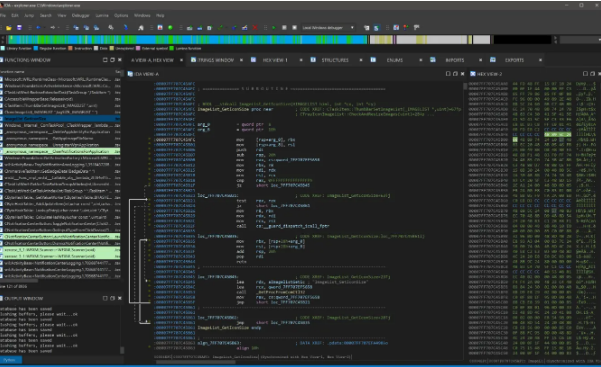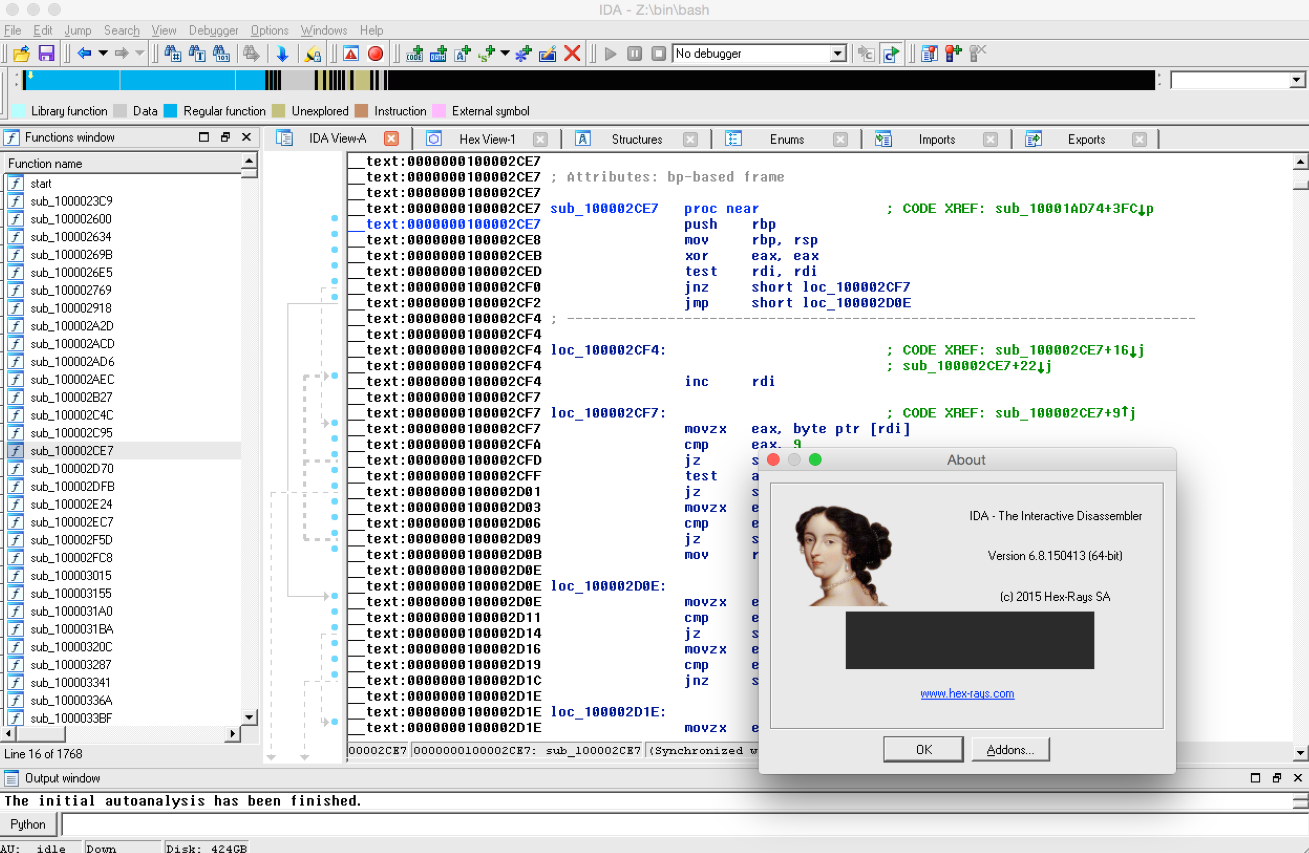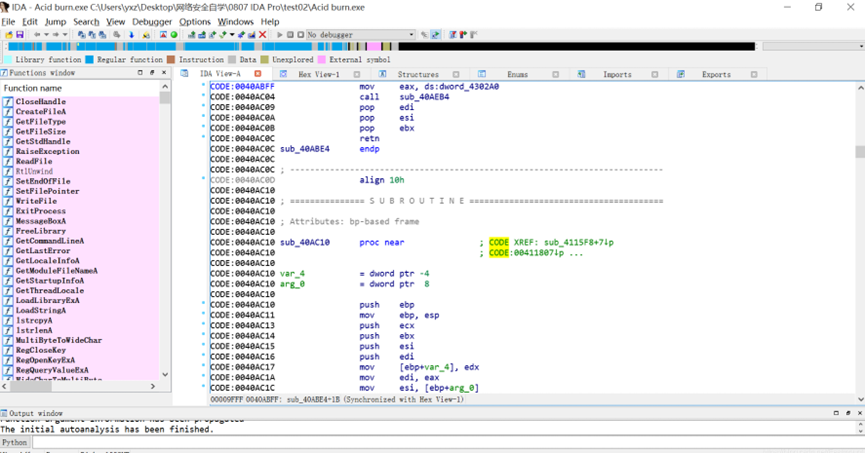行业解决方案查看所有行业解决方案
IDA 用于解决软件行业的关键问题。
发布时间:2023-04-25 11: 38: 37
Action name: Undo
This command reverts the database to the state before executing the last user action. It is possible to apply Undo multiple times, in this case multiple user actions will be reverted.
Please note the entire database is reverted, including all modifications that were made to the database after executing the user action and including the ones that are not connected to the user action. For example, if a third party plugin modified the database during or after the user action, this modification will be reverted. In theory it is possible to go back in time to the very beginning and revert the database to the state state that was present immediately after performing the very first user action. However, in practice the undo buffers overflow because of the changes made by autoanalysis. Autoanalysis generates copious amounts of undo data. Also please note that maintaining undo data during autoanalysis slows it down a bit. In practice it is not a big deal because the limit on the undo data is reached quite quickly (in a matter of minutes). Therefore, if during analysis the user does not perform any actions that modify the database, the undo feature will turn itself off temporarily.
However, if you prefer not to collect undo data at all during the initial autoanalysis, just turn off the UNDO_DURING_AA parameter in ida.cfg.
The configuration file ida.cfg has 2 more undo-related parameters:
UNDO_MAXSIZE max size of undo buffers; default: 128MB
once this limit is reached, the undo info about the oldest
user action will be forgotten.
UNDO_DEPTH max number of user actions to remember; default: 1000000
if set to 0, the undo feature will be unavailable.
Since there is a limit on the size of undo buffers, any action, even the tiniest, may become non-undoable after some time. This is true because the analysis or plugins may continue to modify the database and overflow the buffers. Some massive actions, like deleting a segment, may be non-undoable just because of the sheer amount of undo data they generate.
Please note that Undo does not affect the state of IDC or Python scripts. Script variables will not change their values because of Undo. Also nothing external to the database can be changed: created files will not be deleted, etc.
Some actions cannot be undone. For example, launching a debugger or resuming from a breakpoint cannot be undone.
See also Redo Reset Undo Disable Undo Open undo history
中文翻译:
名称:Undo此命令将数据库恢复到执行最后一个用户操作之前的状态。可以多次应用“撤消”,在这种情况下,将恢复多个用户操作。
请注意,整个数据库将被恢复,包括执行用户操作后对数据库所做的所有修改,以及未连接到用户操作的修改。例如,如果第三方插件在
用户操作期间或之后修改了数据库,则此修改将
被恢复。理论上,可以回到最初的状态,并将数据库恢复到
执行第一次用户操作后立即出现的状态。然而,在实践中,由于自动分析所做的更改,撤消缓冲区溢出。自动分析会
生成大量的撤消数据。此外,请注意,在自动分析过程中维护undodate会使速度减慢一点。在实践中,这并不是什么大不了的事,
因为撤消数据的限制很快就达到了(几分钟内)。因此,如果在分析过程中用户没有执行任何修改数据库的操作,撤消功能将暂时关闭。
但是,如果你不想在初始自动分析过程中收集撤消数据,
只需关闭ida.cfg中的UNDO_DURING_AA参数。
配置文件ida.cfg还有两个与撤消相关的参数:
UNDO_MAXSIZE撤消缓冲区的最大大小;默认值:128MB一旦达到此限制,将忘记有关最旧用户操作的撤消信息。
UNDO_DEPTH要记住的用户操作的最大数量;默认值:1000000如果设置为0,撤消功能将不可用。
由于撤消缓冲区的大小有限制,任何操作,即使是最微小的操作,都可能在一段时间后变得不可撤消。这是真的,因为analysis或插件可能会继续修改数据库并使缓冲区溢出。一些大规模操作,如删除段,可能是不可撤消的,因为它们生成的撤消数据量太大。
请注意,撤消不会影响IDC或Python脚本的状态。脚本
变量不会因为“撤消”而更改其值。此外,
数据库外部的任何内容都不能更改:创建的文件不会被删除,等等。
有些操作无法撤消。例如,启动调试器或从断点恢复是无法撤消的。
另请参阅重做重置撤消禁用撤消打开撤消历史记录
展开阅读全文
︾
读者也喜欢这些内容:
IDA怎么修改汇编指令 IDA修改汇编代码快捷键
在使用IDA Pro进行二进制逆向分析时,经常需要对反汇编得到的代码进行调整和编辑,例如修正误识别的指令、插入特定的跳转逻辑、或清除垃圾代码结构。由于IDA Pro本身具有强大的交互式反汇编能力,因此“IDA怎么修改汇编指令,IDA修改汇编代码快捷键”成为用户搜索频率较高的实操问题。本文将围绕这个话题,从修改步骤到操作技巧全面展开,帮助用户高效掌控IDA Pro的编辑能力。...
阅读全文 >

IDA Pro如何分析多架构代码 IDA Pro怎么做跨架构的反汇编
在复杂的嵌入式开发或固件逆向分析场景中,越来越多的系统采用多种处理器架构混合部署,例如主处理器采用ARM,而辅助模块可能采用MIPS、RISC-V甚至x86。针对这类多架构程序进行静态分析时,传统的反汇编工具显得力不从心。而IDA Pro作为一款功能强大的交互式反汇编工具,在支持多架构分析方面具备显著优势。本文围绕“IDA Pro如何分析多架构代码,IDA Pro怎么做跨架构的反汇编”为核心主题,详细说明操作流程与常见问题。...
阅读全文 >

IDA Pro脚本怎么编写?IDA Pro如何自动化反编译任务?
如果你是从事逆向工程或者恶意软件分析的朋友,应该对IDA Pro这款工具不陌生,IDA Pro有强大的脚本功能,通过它你可以自动化很多工作,省时省力。今天,我们就来聊一聊IDA Pro脚本怎么编写?IDA Pro如何自动化反编译任务?让工作效率更高!...
阅读全文 >

怎么用IDA软件反汇编功能学习汇编指令 IDA反汇编功能如何进行多平台二进制分析
说到反汇编分析,很多人第一时间就会想到IDA。这款工具可以说是做逆向工程的“神器”,不管是学习汇编指令还是分析二进制文件,都非常给力。如果你是个初学者,刚接触反汇编,可能会对IDA的一些功能感到陌生,比如怎么用IDA软件反汇编功能学习汇编指令 IDA反汇编功能如何进行多平台二进制分析。别急,今天就带你一步步搞清楚。...
阅读全文 >